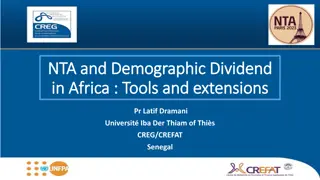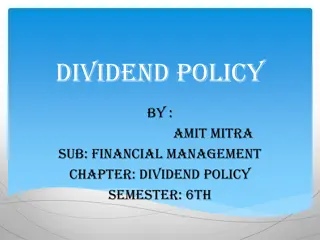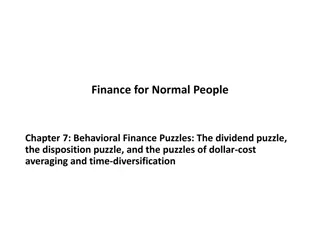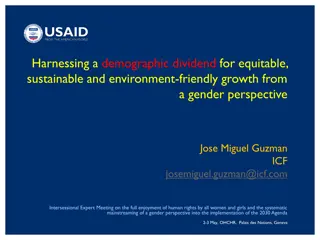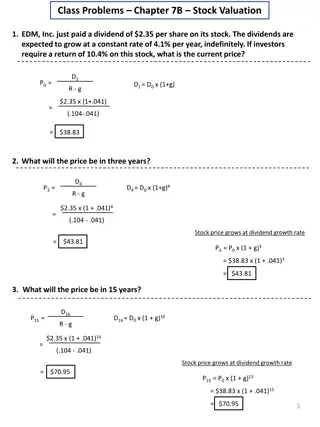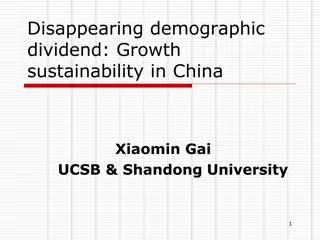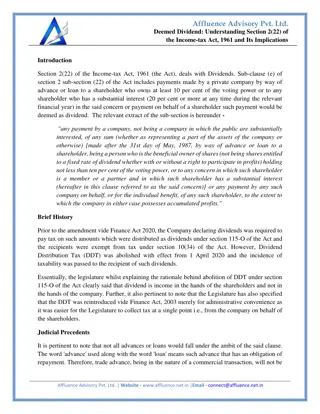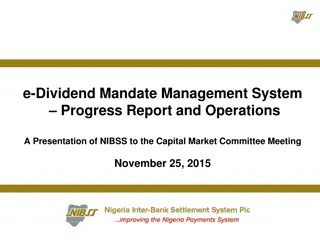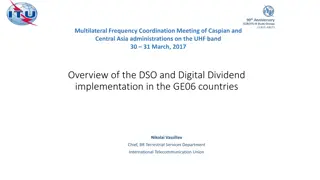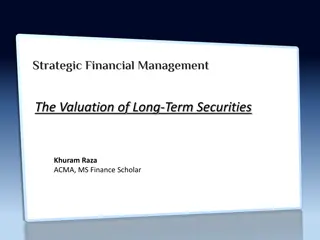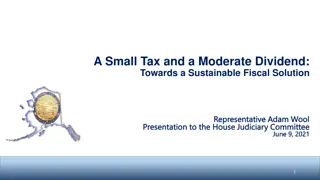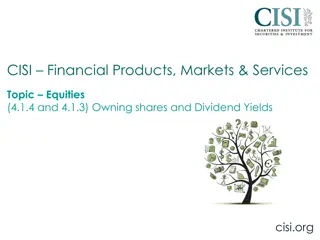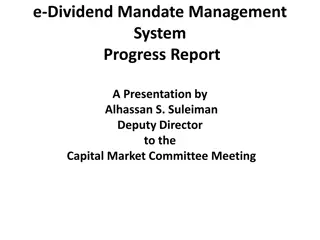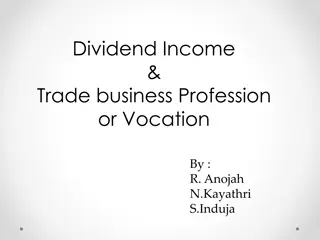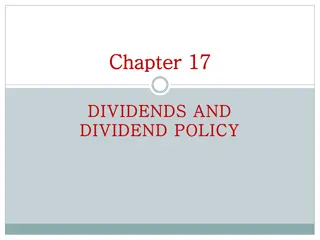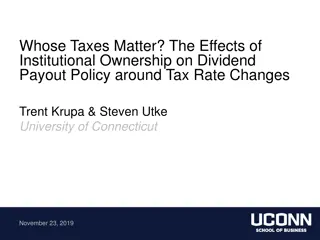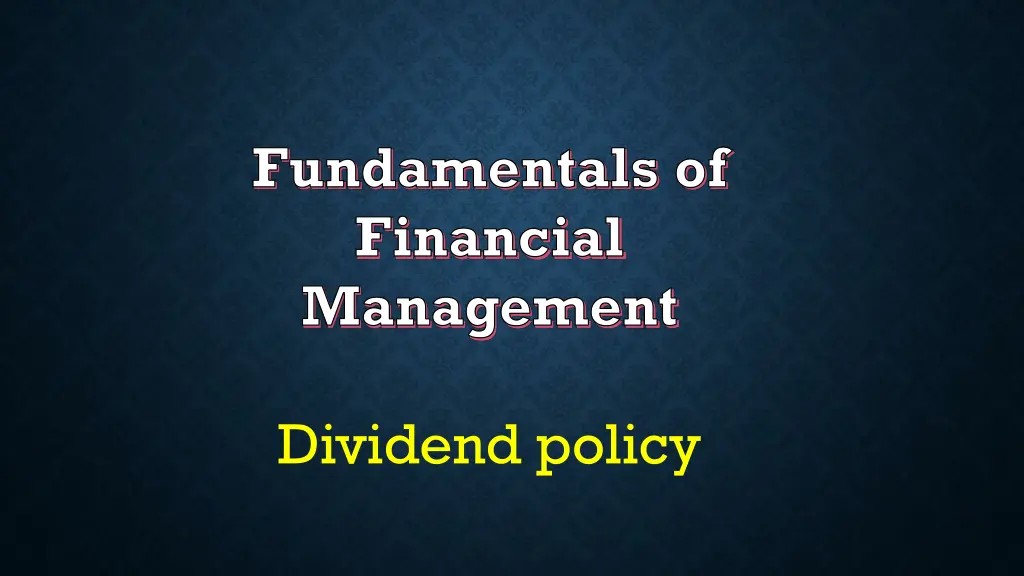
Understanding Dividend Policy in Financial Management
Explore the meaning, significance, and various kinds of dividend policies in financial management. Learn why investors prefer dividends, the impact of dividend decisions on a firm's growth, and the importance of striking a balance between dividends and retained earnings.
Uploaded on | 0 Views
Download Presentation

Please find below an Image/Link to download the presentation.
The content on the website is provided AS IS for your information and personal use only. It may not be sold, licensed, or shared on other websites without obtaining consent from the author. If you encounter any issues during the download, it is possible that the publisher has removed the file from their server.
You are allowed to download the files provided on this website for personal or commercial use, subject to the condition that they are used lawfully. All files are the property of their respective owners.
The content on the website is provided AS IS for your information and personal use only. It may not be sold, licensed, or shared on other websites without obtaining consent from the author.
E N D
Presentation Transcript
Fundamentals of Financial Management Dividend policy
MEANING OF DIVIDEND POLICY Dividend Policy mean that decision of the management through which it is determined how much of net profit are to be distributed as dividend among the shareholders and how much to be retained in the business. Thus , the dividend policies dividend t(he earning after taxes of business into two parts : 1) Funds to Finance Long- term Growth:- The amount of net profit which is retained in nosiness is available to meet the long-term requirements of funds of the business. As a result the firm has to depend less on the external sources. (2). Funds to be Distributed to shareholders: This is the amount which has been set aside by the Board of Directors to be distributed as dividend to the shareholders.
WHY INVESTORS WANT DIVIDENDS (1). Capital Gains:- Capital Gain arises from the transfer of an asset. Investors expect increase in the market value of share (asset) with the passage of time. For example, if the share are purchased for 100 and sold for 130, there will be a capital gain of 30 pr share. (2). Dividned: - Investors also expected a regular dividend on their investment with the firm. The amount of dividend is preferred over retained earnings. Here, we are listing certain factors which explain that ordinary shareholders prefer dividends over capital gain . These factors include: (i). Reduction of Uncertainty (ii). Indication of Strength. (3). Need for Current Income:- Many shareholders want current dividend on their investment because they have to meet their living expenses. Such investors desire dividend income instead of selling their investments. Thus, cash dividend enables investors to get more current income and it does not affect the principal amount.
SIGNIFICANCE OF DIVIDEND POLICY Determination of dividend policy of the firm is one of the important decision of the management. As stated earlier, three important decisions are taken in the area of financial management of a business .These are: (i) Investment Decisions (ii) Financing Decision (iii) Dividend Decision Dividend decision are as much important as the investment and financing decision are. The market value of a firm depends on its dividend policy also. If a firm does not pay a proper return on its equity share capital , it may face difficulty to raise additional funds in future. As a result, the growth of firm is retarded.
KINDS OF DIVIDEND Cash dividend : most of the compaines make payment of dividend in cash campaines Which have sound financial position ,like to play cash dividend .when a companies wants To pay cash dividend ,it should have adequate cash balance ,otherwise it will take loans . When a company follow a stable dividend policy ,the amount required payment of dividend Should be estimated in advance . Stocks Dividend or Bonus Shares :-Under stocks dividend ,the company issues existing Shares holder in a fixed proportion along with cash dividend or in places good ,it issues bonus Shares .with the issues of bonus shares ,total number of shares issues company increase . Intereim Dividend :-Normally dividend is issues at the end of financial year only. The dividend
so paid is called regular dividend .but sometimes the director of company declares dividend Between two annual general meeting of the company . Extra Dividend :-General the directors of a company do not want to charges the rate Of property dividend suddenly because it may cause fluctuation in the prices of shares . when a company earns handsome profit in any year ,it gives somes extra dividend to Sharesholders along with the regular dividend . Property Dividend :- Under this form ,dividend is paid in kinds rather than in cash .It is called property dividend .For example ,if a company ,manufacturing sugar ,gives dividend dividend in the form of sugar to its sharesholders ,it will be called property dividend.
Scrip dividend :-When a company gives dividend in the form of shares of shares/ debentures of other compains .It is knows as scrip dividend .the method is also not pratised in india . Bond Dividend :-To prevent the outflow of cash ,company can gives dividend to its shares holders in the form of bonds also . Composite dividend :- When a part of dividend is paid in cash and another part in the form of property ,it called composite dividend .
ADVANTAGES OF STOCK DIVIDEND Stock dividend is beneficial to both the shareholders and the company. Following are the advantages of stock dividend. (1). To Shareholders I. Tax benefit :- When dividend is paid in cash , it is include in the income of the shareholder and they have to pay tax on it but on bonus share, they don t have to pay any tax. Maoreover,when these bonus share are sold, shareholders have to pay capital gain tax at rate which is much lower than the rate of income tax payable on cash dividend. II. Indication of Higher Future profits :- By release of stock dividend , the shareholders come to observe that company has good profitability .The market price of share is favourably affected. But in case the profit of company do not increase considerably after issuing bonus share , the earning per share may decrease and the market value of the share may fall. III. Future Dividend may Increase :- IF f regular cash dividend is continued along with the bonus shares, total future cash dividend for the shareholders may increase . For example , a company pays cash dividend at the rate of 2per share and issues bonus share at the rate of 10 per cent. It also declares that in future the rate of a cash dividend will not be reduced. A shareholder who has 100 shares will get 200 cash dividend and 10 bonus
(iv). High Psychological Value :- By issuing stock dividend , there may be favourable psychological impact on shareholders. It encourages investment in shares, as a result market value of share and to earn capital gains. Their original amount is also safe. Stock dividend is an indicator of the growth of the company. It raise market value of shares. (v). Retains Proportional Ownership for Shareholders :- Stock dividend is different from issue of new shares .If the existing shareholders do not have adequate amount to purchase new shares, their proportional ownership in company will reduce because new investor will enter the company . By stock dividend , this unfavourable effect can be avoided.
(2). TO COMPANY (I). Conserves cash :- Stock dividend allows the company to pay dividend without outflow of cash. Thus, the cash saved can be used for other routine and developmental activities and the company has to depend a little on external sources. (ii). Only Means to Pay Dividend in Time of Financial Difficulty :- When a company has adequate income and wants to pay dividend but it does not have sufficient cash , stock dividend is the only alternative. Indian companies cannot pay stock dividend in lieu of cash dividend. (iii). More Attractive Sale Price :- Sometimes, company wants to lower the market price of the shares by issuing stock dividend to attract the investors towards its shares. It increase trading activity in the shares of company in the stock exchange.
TYPES OF DIVIDEND POLICY Steady dividend at the present level policy:-This is perhaps the most common dividend policy .Under this policy ,the same rate of dividend is paid at gives in the year . The shares holders are able to meet their expectation of dividend and the makes shares is least affected . Steady Dividend at a lower level policy :-Under this policy ,dividend in paid by shares holders at a rate which is lower than that of previous year .Managers policy when more profitable investment to opportunities are available firm funds .this policy reduces the present earnings of the shares holder and may also market price of the shares adversely Steady Dividend at Higher Level Policy :- Under this policy management rate dividend in the in the current year as company to the previous year . This policy is the when the earning of the earning of a firm are growing and likely to grow further in future and the firm does not need funds
Dividend Fluctuating With Earning Policy :- Under this policy ,dividend fluctuates with fluctuates in earning .This is not a good policy because there is feeling of uncertainly among the share holder about the payment of dividend , which causes an adverse effect on the market price of share of such company . Low Regular Dividend Plus Extra Dividend :- Under this policy ,company determines a low rate of dividend which is paid regular but in the year of good profit ,it also pays extra dividend .This policy is followed by those businesses which do not have stable income .
Policy of Eliminating the Dividend Entirely :- This is the late of the dividend policies .Under it , management decides not to pay any dividend .This policy may be followed due to two reason . firstly , company might be passing through crisis and it does not have the capacity to pay dividend . Secondly :- the firm may have better investment opportunities . By following the policy of no dividend ,the market value of the shares may fall. Strict dividend policy Liberal Dividend Policy
SIGNIFICANCE OF STABILITY OF DIVIDEND Investor, Desire For Current Income:- Current investors are such who when to get regular income ,for example , superannuated and aged people ,women and children. They invest in the share to meet their living expense out of dividend income .Stable dividend provides them relief and saves from such expenses Resolution Of Investors Uncertainly :- Dividend and change in dividend act a information about the profitability of the firm . When a firm follows a stable dividend policy , it will not change the rate of dividend despite a change in its income . Institutional Investors Requirements :- The share of companies are not only purchased by individual but also by institutional investor like IFSI , IDBI , LIC , GIC, UTI , ETC . They purchased the shares in bulk quantities and , thereby affect the market price of these shares .
Raising Additional Finances :- A stable dividend policy beneficial to the company .By following such a policy , company can get external finances conveniently . Investors want make long term investment in such a firm .Stable dividend policy increase their faith in the company. When the company issues new shares, such investor will try to purchase them . Such companies can also issues preference shares or debentures because the public knows that the company has stable dividend policy . Routinizing Of dividend Decision :- By following stable dividend policy , the board of director need not discuss the level of dividend time and again . Thus , the board can discuss other important matter .
FACTOR DETERMINING DIVIDEND POLICY The following factor effect dividend policy of a firm Financial needs of the company :- While determining the dividend policy, the board director should consider the future financial requirement of the firm . Retained earning should be used as a source of finance , when profitable opportunities are available to the company . Stability of dividend :- Another factor determining the dividend policy is the stability dividend . This factor has been discussed in detail above .While determining the dividend policy , the advantage of stability of dividend , including the desire of investor for current income ,resolution . Legal Requirements :- Company dividend policy must also be in conformity with legal requirements .AS
per legal provisions , a company cannot pay dividend out of its paid a capital .Therefore , the board of directors must consider the fact that the dividend is not before paid out of capital .Under Section 205 of the companies Act , dividend of company can be Similarly , if there are accumulated losses ,these must be set off against current year . Liquidity :- The payment if dividend result in outflow of cash .It is possible that income of the company is adequate , but it does not has necessary cash to pay dividend . Thus can position is an important determining in dividend policy .Better the cash position of companies better will be its ability to pay dividend . Growth prospects :- If a company has better growth prospects , it will need more and financial. In such a case , it will retain its maximum income and distribute is small part as dividend .
Control :- The management of the company can also affect its dividend policy to maintain its control. When company pays cash dividend, its cash position is affect and it has to issue new shares to finance its new project. If the present shareholders can t purchase the new shares, their control is diluted. In such a case , dividend rate can be reduced and profit retained to enable the present management to continue with the control of the company. Taxes:- The dividend policy of a company is also based on income tax position of the shareholders. If most of the shareholders of a company are in high tax bracket, company should retain most of its profits. As a result, the shareholders will get capital gains only and the tax rate on capital gains is comparatively lower as compared to tax on dividend income. Investment Opportunities :- If the shareholders can earn better rate of return on their investment as compared to company,, the company should pay high dividend to its investor. In case, more profitable opportunities are available to the firm, it should retain most of its earning and pay lesser dividend.
DIVIDEND THEORIES / MODELS As already discussed, the financial manager has to take three major decisions, namely Financial Decision, Investment Decision , and Dividend Decision . The main objective of all the three decision is to maximise shareholders wealth . Thus , dividend decision is also equally important like other financial decision. Under dividend decision, the finance manager has to decide whether to distribute the profits among the shareholders as dividend or to retain the same in the company . The financial management will choose that alternative which would maximise the shareholders wealth. If dividend are distribute. It may increase the market value of shares, but at the same time it may adversely affect the cash position of the firm. On the other hand, if earning are retained instead of distributing dividend, it may reduce the market value of share. However, the earning so retained can be used by the company to meet its future financial requirement for expansion, modernisation and diversification. In actual practice, a company may distribute a part of the profits as dividend and retain the remaining amount to meet its financial requirements. Thus , the theories/models explaining the relationship between dividend policy and value of the firm can be dividend into two groups. The one relating to the irrelevance of dividend to the valuation of the firm (Modigliani Miller Approach ) and the other regarding the relevance of dividend ( Walther s Model , and Gordon s Model).
MODIGLIANI MILLER APROACH (THEORY OF IRRELEVANCE OF DIVIDEND) According to Modigliani and Miller , dividend policy of a has no effect on the value of the firm. Dividend are irrelevent of the shareholders wealth. According to them ,the price of share of a firm is determined by its earning power and investment decision of dividing the earning into dividend distribution and retained earning. Their argument is based on certain assumptions which are given below. Assumption (i). Capital markets are perfect. (ii). Investor are rational. Information is freely available to them and there are no flotation and transaction costs. (iii). The are either no taxes or there is no difference in the dividend tax and tax on capital gains. (iv). The investment policy of them is given and does not change. (v). The investors are able to forecast future prices and dividend with certainty.
EXPLANATION The essence of Modigliani-Miller approach as to the irrelevance if dividend lies in the arbitrage process. They say that when a company pays dividend, it has a positive impact on the market price of the share of the company consequently the value of the company increase .But due to payment of dividend, the funds available to the company to finance its projects will fall short. Therefore, to meet the shortage of funds , the company would issue new equity shares. The issue of new equity shares will increase the supply of equity shares in the market which reduced the market price of the shares Thus, the increase in the market price of shares due to payment of dividend will be offset by decrease in the market price of share due to issue of new shares. The market price before and after the payment of dividend would be the same.
CRITICAL OF MM MODEL MM approach has been criticised because of unrealistic of unrealistic assumptions on the basic of which MM model was formulated . It has been criticised on various ground which are explained as follows: 1. No Taxes :- Modigliani Miller approach assume that there are no taxes. It is not a realistic assumption. In actual practice, shareholders have to pay tax. Beside this, the tax rates differ for dividend income and capital gains. Normally, capital gains are taxes at lower rate as compared to dividend . Because of tax differential , the internal financing will be cheaper in comparison to external financing. Hence , shareholders would prefer the dividend policy of retention pf earning rather than the payment of dividend due to difference in tax rates. 2. No Flotation Costs:- The model assume that there are no flotation costs. But in practical life, a company has to incur flotation cost in the form of cost of underwriting and brokers commission at the time of issuing new shares. This adversely affect the amount received from the issue of fresh shares. 3. No Transaction Costs :- Due to the assumption of perfect capital markets the Modigliani Miller approach assume that there are no transaction costs. But in actual practice, the shareholders are required to pay transaction costs in the form of brokerage when they sell the shares . So, if the firm does not distribute dividend , the shareholders may have to sell the shares to meet his current consumption needs equivalent to his dividend income But because of transaction costs, he will be required to sell more shares.
(4). Use of Single Discount Rate :- Modigliani Miller approach that one discount rate is used to discount the cash flows arising in different periods. It is not correct, However, the uncertainty increases as the time period increase . Cash flows of distant future should be discounted with higher discount rate in comparison to the flows arising in the near future. (5).Use of Equity Capital to Finance New Project :- It is assumed that project will be financed with the help of equity capital only. But in practice more than one source of finance may be used to finance a new project.
GORDONS MODEL (RELEVANCE OF DI VIDEND POLICY Myron Gordon also proposed a model of relevance of dividend policy for valuation of a firm. According to Gordon, the dividend policy of a firm affect its value. This model is called dividend growth model. This model assumes a constant level of growth in dividend over a long life. The formula for valuation of share as given by Gordon is as under : P = (1-b)/ Ke-br Where P = Price per share E = Earning per share (1-b) = Percentage of earning distributed as dividends b = Percentage of earning retained . Ke = Required /expected rate of return or cost of capital R = Rate of return on investment Br = Growth rate of earning and dividends.
Assumptions Gordon s Growth model is based on the following assumptions : (i). Retained earning are only source of financing and no external financing is used (ii). The rate of return on firm s investment remains constant. (iii). The firm has a long life. (iv). Tax does no exist. (v). Cost of capital (ke) remain constant and is greater than the growth rate. (vi). The growth rate of the firm is constant and it is the product of its retention ratio and its rate of return.


